Sumitomo Bakelite Bundle
Who Does Sumitomo Bakelite Serve?
Understanding the Sumitomo Bakelite SWOT Analysis is essential for grasping its market position. Sumitomo Bakelite, a titan in advanced plastics, navigates a complex global landscape. Its success hinges on a deep understanding of its customer demographics and target market. This exploration delves into the company's evolution and its strategic adaptation to meet diverse customer needs.
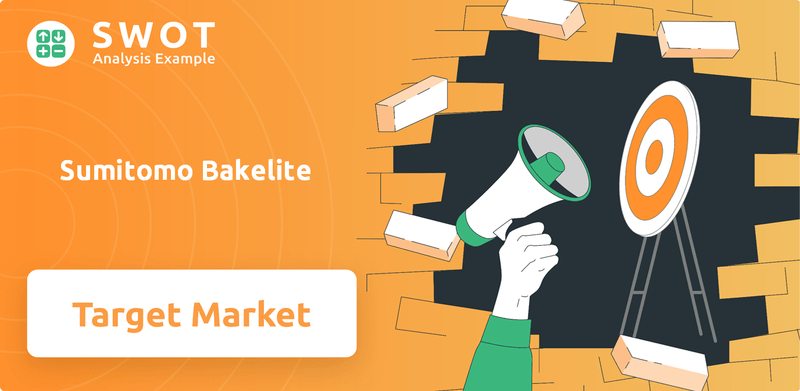
This analysis of Sumitomo Bakelite's customer profile and target audience will reveal key insights into its industry focus. We'll uncover who are Sumitomo Bakelite's main customers, and how the company segments its market. Furthermore, the examination will cover Sumitomo Bakelite market analysis, including its customer acquisition strategies and customer satisfaction, providing a comprehensive view of its competitive landscape and target market size and growth.
Who Are Sumitomo Bakelite’s Main Customers?
Understanding the customer demographics Sumitomo Bakelite serves is key to grasping its market position. The company operates primarily in a Business-to-Business (B2B) model, focusing on industrial clients rather than individual consumers. This approach shapes its Sumitomo Bakelite customer profile and target market dynamics.
Sumitomo Bakelite's target market is defined by the industries it supports and the technical needs of those sectors. Key customer groups include manufacturers in the automotive, electronics, healthcare, and housing industries. These clients rely on Sumitomo Bakelite for specialized materials.
The company strategically targets manufacturers needing high-performance materials. This includes major vehicle manufacturers, component suppliers, semiconductor manufacturers, and medical device producers. The focus is on providing advanced material solutions to meet the evolving demands of these industries.
Customers include vehicle manufacturers and component suppliers. They require high-performance materials for parts like brake linings and electrical components. The demand for durable and reliable materials is consistently high within this sector.
This segment comprises semiconductor manufacturers and electronic device assemblers. Advanced materials are essential for encapsulation, insulation, and heat dissipation. The electronics segment is a significant revenue driver.
Medical device manufacturers and pharmaceutical packaging companies are key customers. They seek specialized plastics for sterile environments and precise applications. The healthcare sector demands stringent material quality.
Manufacturers of building materials and components are included. They need materials that offer durability, insulation, and compliance with safety standards. The housing sector represents a stable market for specific products.
The electronics segment, particularly semiconductors, is a major revenue source for Sumitomo Bakelite. This growth is driven by trends like 5G technology and the Internet of Things. The company has strategically shifted towards higher-value materials.
- Sumitomo Bakelite's focus on advanced molding compounds for semiconductor encapsulation is critical.
- The company's investments reflect the growing demand for specialized materials.
- Understanding Sumitomo Bakelite's target audience requires analyzing its industry focus and customer needs.
- For more detailed information, you can explore Owners & Shareholders of Sumitomo Bakelite.
Sumitomo Bakelite SWOT Analysis
- Complete SWOT Breakdown
- Fully Customizable
- Editable in Excel & Word
- Professional Formatting
- Investor-Ready Format
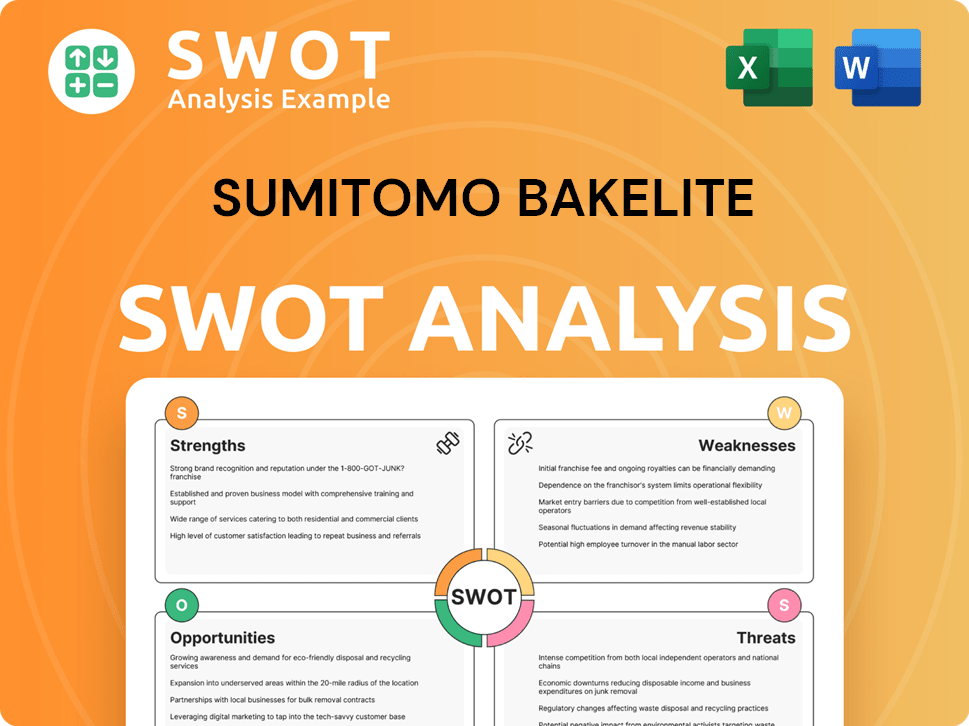
What Do Sumitomo Bakelite’s Customers Want?
Understanding the customer needs and preferences is crucial for companies like Sumitomo Bakelite. The company's success hinges on its ability to meet the specific demands of its diverse customer base. This involves a deep understanding of the technical requirements and purchasing behaviors within various industries.
The primary drivers for Sumitomo Bakelite's customers are centered around performance, reliability, innovation, and cost-effectiveness. Customers are looking for materials that offer superior mechanical strength, thermal resistance, electrical insulation, and chemical stability. These factors are essential for ensuring the longevity and performance of end products, such as those in the automotive and electronics sectors.
The Sumitomo Bakelite customer profile is defined by a focus on high-quality, reliable components that ensure the performance and safety of the end product. A key aspect of this involves custom material formulations to meet unique application challenges. Market trends, such as sustainability and miniaturization, significantly influence product development, with the company developing biomass-based thermosetting resins. For more insights, consider exploring the Marketing Strategy of Sumitomo Bakelite.
Customers need materials that offer superior mechanical strength, thermal resistance, electrical insulation, and chemical stability. These properties are critical for product performance and longevity.
Customers are motivated by the need for reliable, high-quality components that ensure the end product's performance and safety. This includes the need for custom material formulations to meet unique application challenges.
Customers prefer materials that contribute to vehicle lightweighting for improved fuel efficiency and reduced emissions in the automotive sector. In electronics, they seek materials with excellent dielectric properties.
Purchasing behaviors are highly technical and often involve long sales cycles. Decisions are driven by rigorous testing and adherence to industry standards. Long-term supply chain stability is also a key factor.
Sumitomo Bakelite tailors its product features and technical support to specific segments, offering specialized grades of materials for different applications, alongside comprehensive technical assistance. This helps meet evolving customer demands.
The company is developing biomass-based thermosetting resins in response to growing environmental consciousness and regulatory pressures. This demonstrates a commitment to innovation and sustainability.
The Sumitomo Bakelite target market includes various industries, each with specific needs. Understanding these segments allows the company to tailor its offerings effectively.
- Automotive: Requires materials that contribute to lightweighting, fuel efficiency, and safety.
- Electronics: Needs materials with excellent dielectric properties, low thermal expansion, and high purity.
- Industrial: Demands materials that offer resistance to harsh environments and ensure long-term performance.
- Aerospace: Focuses on high-performance materials that meet stringent safety and reliability standards.
Sumitomo Bakelite PESTLE Analysis
- Covers All 6 PESTLE Categories
- No Research Needed – Save Hours of Work
- Built by Experts, Trusted by Consultants
- Instant Download, Ready to Use
- 100% Editable, Fully Customizable
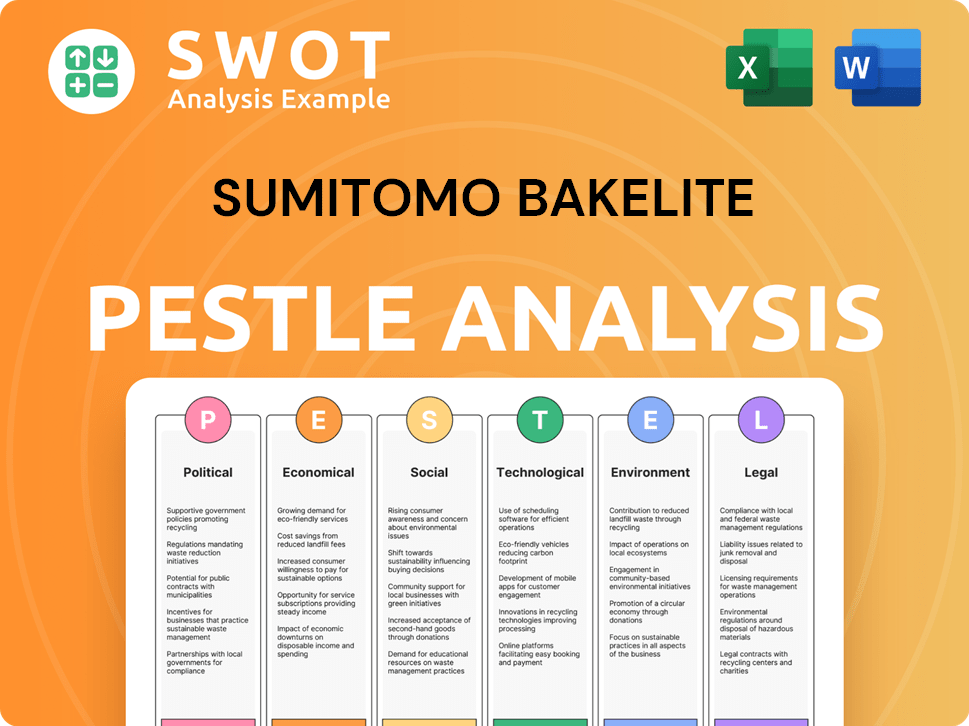
Where does Sumitomo Bakelite operate?
The company maintains a substantial global footprint, with a significant presence in Asia, Europe, and North America. Its operations and sales networks are strategically positioned to serve key industrial sectors. The company's market strategy is deeply intertwined with its geographical reach, adapting to regional demands and regulatory environments.
East Asia, particularly Japan, China, and South Korea, forms a cornerstone of the company's market presence, driven by the robust electronics manufacturing and automotive industries in the region. Southeast Asia also plays a crucial role, supported by manufacturing facilities and sales offices catering to the expanding industrial base. In Europe and North America, the company focuses on specific sectors, tailoring its offerings to meet regional standards.
Understanding the nuances of customer demographics is crucial for the company's success. The company adapts its product specifications, establishes local R&D centers, and tailors marketing strategies to align with regional business practices. Recent expansions focus on emerging markets, while strategic adjustments occur based on market saturation and global manufacturing shifts.
East Asia, including Japan, China, and South Korea, represents a primary market for the company. These countries are major hubs for electronics manufacturing and automotive production, driving significant demand for the company's products. The company's strong presence in this region is supported by its deep understanding of local market needs and preferences.
Southeast Asia is another crucial market for the company, with growing industrial bases. The company has manufacturing facilities and sales offices in this region, serving its expanding industrial sector. This strategic positioning allows the company to capitalize on the region's increasing demand for industrial materials.
In Europe, the company targets key markets such as Germany, France, and the United Kingdom. The company caters to the automotive, industrial, and healthcare sectors in these regions. The company's strategy involves adapting its products to meet regional standards and regulations.
North America, particularly the United States, is a crucial market for the company, especially for high-performance materials. The company focuses on advanced electronics and specialized industrial applications in this region. The company's approach includes establishing local R&D and technical support centers.
The company's geographic distribution of sales reflects the concentration of its target industries. The company generates significant revenue from the major electronics and automotive manufacturing regions. For more insights into the company's strategic growth, consider reading the Growth Strategy of Sumitomo Bakelite.
Sumitomo Bakelite Business Model Canvas
- Complete 9-Block Business Model Canvas
- Effortlessly Communicate Your Business Strategy
- Investor-Ready BMC Format
- 100% Editable and Customizable
- Clear and Structured Layout
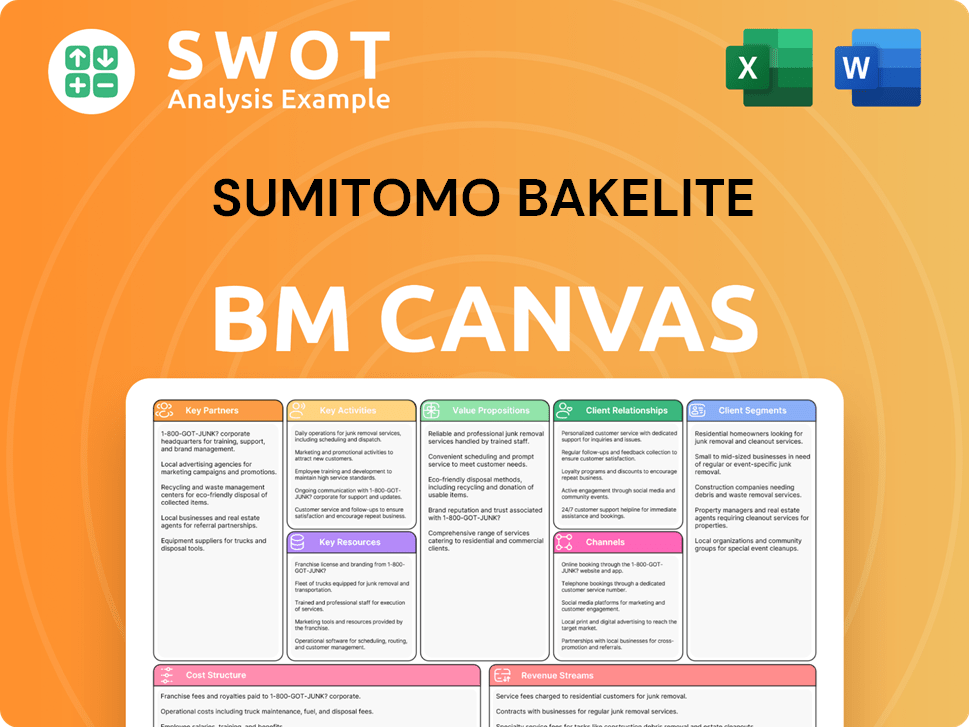
How Does Sumitomo Bakelite Win & Keep Customers?
Customer acquisition and retention strategies at the company are primarily business-to-business (B2B) focused, emphasizing technical expertise, strong relationships, and reliable supply chains. The company's approach is tailored to the specific needs of its target market, ensuring long-term partnerships and customer satisfaction. Understanding the customer demographics and target market is crucial for the company's continued success.
Acquisition efforts often start with direct sales teams engaging potential clients in target industries. They also attend industry trade shows and participate in technical conferences. Digital marketing channels like the company website and industry-specific online platforms are used to showcase product capabilities and technical specifications. The company leverages its reputation for quality and innovation within the industry. Sales tactics involve technical consultations, providing samples for testing, and collaborative development of customized material solutions.
Given the long-term nature of B2B relationships, customer retention is crucial for the company. This is achieved through consistent product quality, reliable delivery, and responsive after-sales service, including technical support and troubleshooting. Customer data and CRM systems are vital for managing client relationships, tracking order history, and understanding evolving needs. The company continuously seeks feedback to improve its offerings and service, aiming to deepen customer loyalty and increase lifetime value.
The company's sales teams directly engage with potential clients in target industries. This includes attending industry trade shows and technical conferences to build relationships and showcase products. This approach allows for personalized interactions and the opportunity to understand specific customer needs. This is a key part of how the company identifies its target market.
The company utilizes digital marketing channels, including its website and industry-specific online platforms. These platforms showcase product capabilities and technical specifications. This strategy helps to reach a broader audience and provide detailed information to potential customers. This is a key element in the company's customer acquisition strategies.
Sales tactics often involve extensive technical consultations, providing samples for testing, and collaborative development of customized material solutions. This approach ensures that the company meets specific customer requirements. This helps to build strong relationships and foster customer loyalty. Understanding the customer needs is crucial.
Customer data and CRM systems are crucial for managing client relationships, tracking order history, and understanding evolving needs. These systems help the company maintain strong relationships and provide responsive service. CRM systems are essential for customer retention and understanding the customer base.
The company focuses on several key strategies to retain its customers. These include consistent product quality, reliable delivery, and responsive after-sales service. The company aims to build long-term relationships through these efforts. For more insights, consider reading about the Competitors Landscape of Sumitomo Bakelite.
- Product Quality: Ensuring consistent product quality is a cornerstone of the company's retention strategy.
- Reliable Delivery: The company emphasizes reliable and timely delivery to meet customer production schedules.
- After-Sales Service: Responsive after-sales service, including technical support and troubleshooting, is provided to address customer needs.
- Customer Feedback: Continuously seeking customer feedback to improve offerings and service.
Sumitomo Bakelite Porter's Five Forces Analysis
- Covers All 5 Competitive Forces in Detail
- Structured for Consultants, Students, and Founders
- 100% Editable in Microsoft Word & Excel
- Instant Digital Download – Use Immediately
- Compatible with Mac & PC – Fully Unlocked
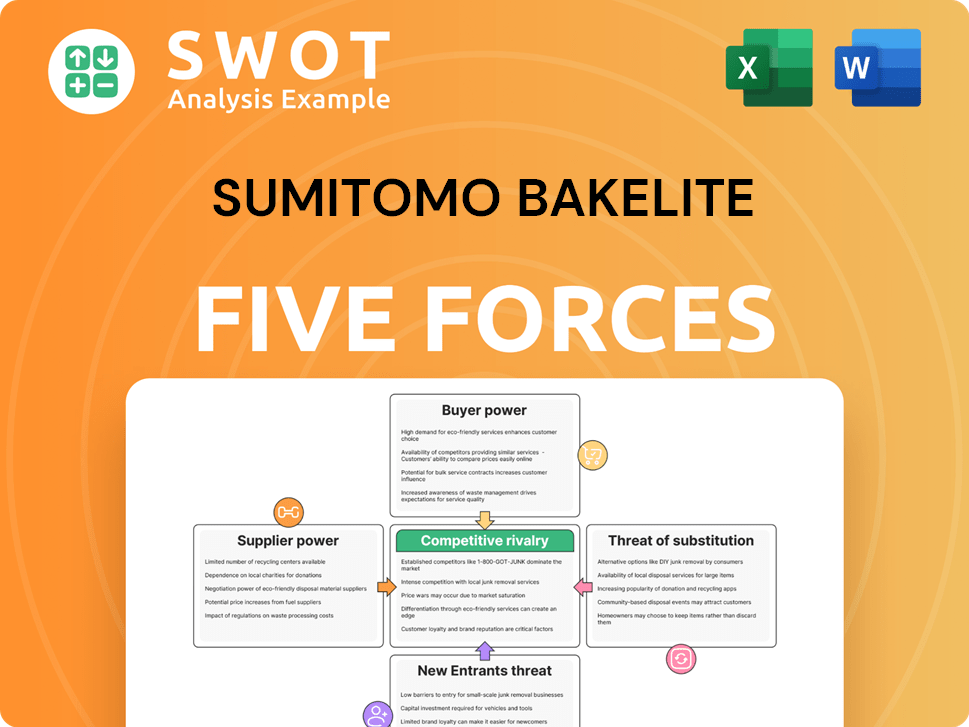
Related Blogs
- What are Mission Vision & Core Values of Sumitomo Bakelite Company?
- What is Competitive Landscape of Sumitomo Bakelite Company?
- What is Growth Strategy and Future Prospects of Sumitomo Bakelite Company?
- How Does Sumitomo Bakelite Company Work?
- What is Sales and Marketing Strategy of Sumitomo Bakelite Company?
- What is Brief History of Sumitomo Bakelite Company?
- Who Owns Sumitomo Bakelite Company?
Disclaimer
All information, articles, and product details provided on this website are for general informational and educational purposes only. We do not claim any ownership over, nor do we intend to infringe upon, any trademarks, copyrights, logos, brand names, or other intellectual property mentioned or depicted on this site. Such intellectual property remains the property of its respective owners, and any references here are made solely for identification or informational purposes, without implying any affiliation, endorsement, or partnership.
We make no representations or warranties, express or implied, regarding the accuracy, completeness, or suitability of any content or products presented. Nothing on this website should be construed as legal, tax, investment, financial, medical, or other professional advice. In addition, no part of this site—including articles or product references—constitutes a solicitation, recommendation, endorsement, advertisement, or offer to buy or sell any securities, franchises, or other financial instruments, particularly in jurisdictions where such activity would be unlawful.
All content is of a general nature and may not address the specific circumstances of any individual or entity. It is not a substitute for professional advice or services. Any actions you take based on the information provided here are strictly at your own risk. You accept full responsibility for any decisions or outcomes arising from your use of this website and agree to release us from any liability in connection with your use of, or reliance upon, the content or products found herein.